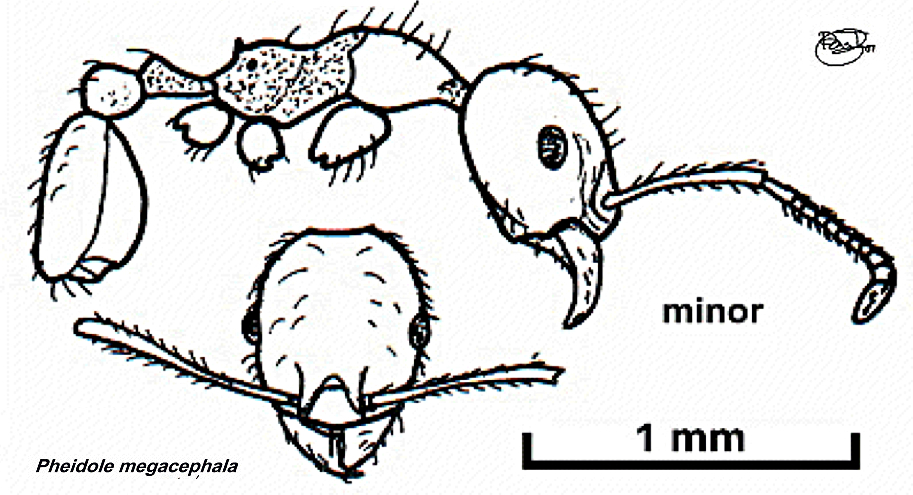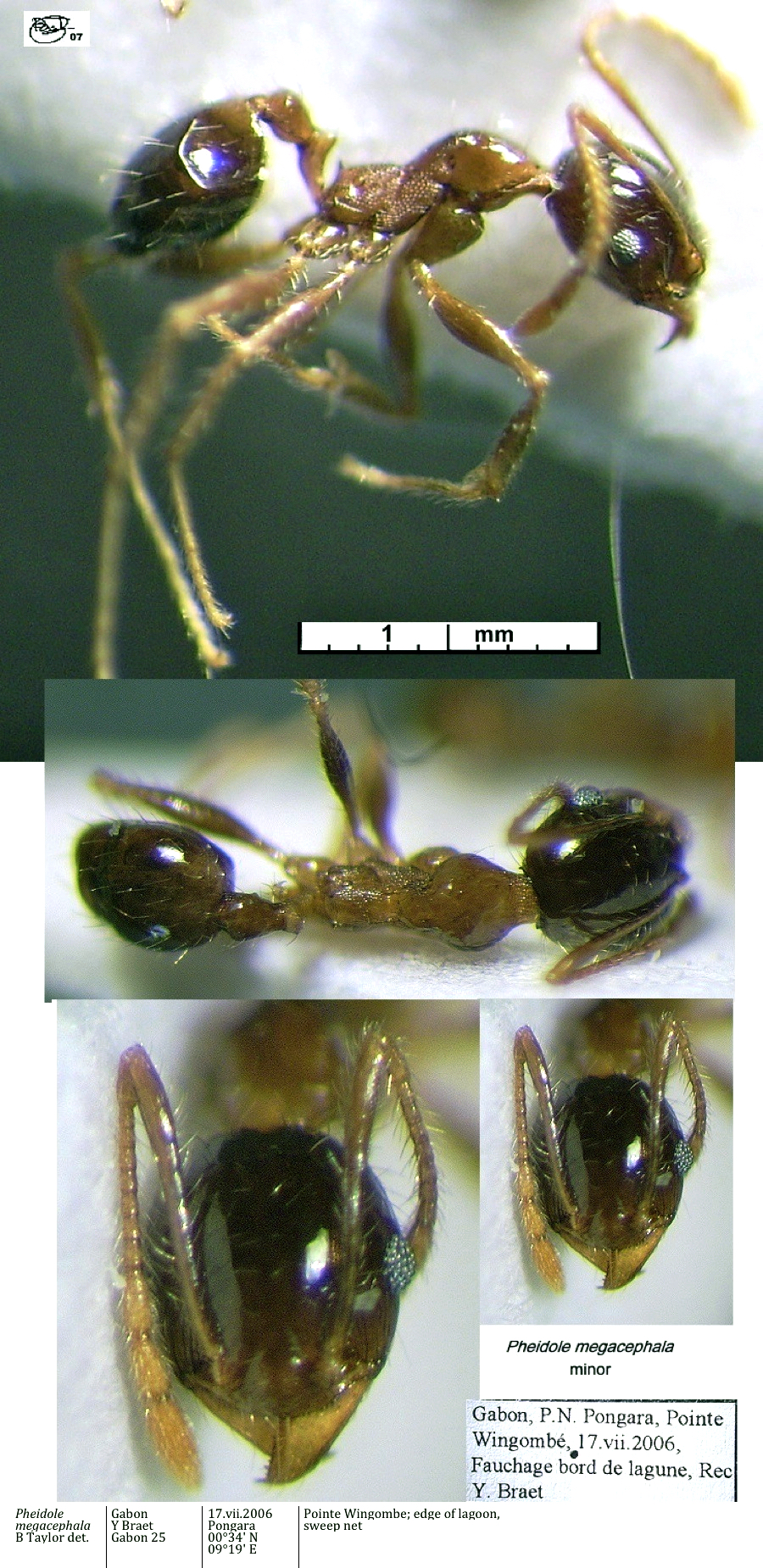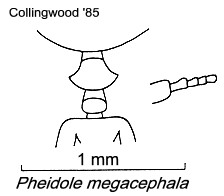Pheidole megacephala (Fabricius)
  Iran list Iran list
 Type location not known (Formica
megacephala, Fabricius, 1793: 361, major) [note Wheeler, 1922, has
the type locality as Mauritius = "Isle de France", as per the
specimen label, see photomontage on the linked majors page (see below);
but Forel,
1891: 176, reckoned
the location was Madagascar] Type location not known (Formica
megacephala, Fabricius, 1793: 361, major) [note Wheeler, 1922, has
the type locality as Mauritius = "Isle de France", as per the
specimen label, see photomontage on the linked majors page (see below);
but Forel,
1891: 176, reckoned
the location was Madagascar]
Subspecies (Bolton,1995)
duplex (Pheidole
megacephala F. v. duplex
n. var., Santschi, 1937d:
218,
major, minor & queen) from Angola - see http://www.antweb.org/specimenImages.do?code=casent0906513
appear identical to the fresh specimens I have (linked pages)
junior synonyms
perniciosa (Oecophthora perniciosa,
n. sp., Gerstäcker, 1859: 263, minor; junior synonym of megacephala,
Emery, 1915j: 235) from Mozambique - see (headless) http://www.antweb.org/specimenImages.do?code=casent0906517
laevigata (Myrmica
(?) laevigata sp. nov., F Smith, 1855b: 130, illustrated,
minor; junior synonym
of pusilla, Roger, 1859: 259, of pallidula, F Smith,
1858a: 282; of megacephala, Roger, 1863b: 30; of pusilla,
Emery, 1915j: 235) from Great Britain, collected at Battersea
[also name used by Mayr,
1862: 747, minor, for specimen from Brazil]
scabrior
(Pheidole megacephala var. scabrior nov. var., Forel, 1891b:
178, major, minor, queen and male) from Madagascar; see linked page; the
major matches the light coloured major I have from Kenya 2010-02; the
minor matches the Kenya 2010-10.
speculifrons
(Pheidole megacephala F. v. speculifrons n. v., Stitz, 1911b:
386, major & minor)
from Tanzania, Bukoba - on linked pages (see below)
suspiciosa (Myrmica
suspiciosa, F.
Smith, 1859a: 148, minor; junior synonym of megacephala,
Donisthorpe, 1932c: 455) from Indonesia, Aru - see http://www.antweb.org/specimenImages.do?code=casent0901409.
testacea (Atta
testacea, F Smith, 1858b: 168, major & minor; junior synonym of
megacephala, Brown, 1981: 530) from Brazil  . .
Note Fischer & Fischer (2013) designated a
"neotype"; I feel that was unnecessary given that good specimens of the
junior synonyms exist, e.g. duplex.
[Fischer, G.; Fisher, B. L. 2013. A revision of Pheidole Westwood (Hymenoptera:
Formicidae) in the islands of the Southwest Indian Ocean and
designation of a neotype for the invasive Pheidole megacephala. Zootaxa
3683:301-356.] It, perhaps, is worth noting that although they examined
many specimens, from Africa they listed only a few samples from East
Africa and very few of the listed types of their junior synonyms.
|
Fabricius's (1793) description is at  . F Smith's
(1855b) description of laevigata
(worker) is at . F Smith's
(1855b) description of laevigata
(worker) is at  . F Smith's
(1859a) description of Myrmica suspiciosa
(worker) is at . F Smith's
(1859a) description of Myrmica suspiciosa
(worker) is at  .
Gerstäcker's (1859) description of perniciosa
(worker) is at .
Gerstäcker's (1859) description of perniciosa
(worker) is at  .
Forel's (1891b) description of megacephala and varieties from
Madagascar is at .
Forel's (1891b) description of megacephala and varieties from
Madagascar is at  and and  .
Forel's (1907g) description of ilgi is at .
Forel's (1907g) description of ilgi is at  .
Stitz's (1911b) description of speculifrons
is at .
Stitz's (1911b) description of speculifrons
is at  .
Emery (1915j) sought to clarify the megacephala-group
of species, with notes and illustrations - see .
Emery (1915j) sought to clarify the megacephala-group
of species, with notes and illustrations - see  .
Emery (1919a) gave notes and illustrations - see .
Emery (1919a) gave notes and illustrations - see  .
Arnold's (1920a) translation of ilgi (as ilgii) is at .
Arnold's (1920a) translation of ilgi (as ilgii) is at  .
Santschi's (1937d) description of duplex
is at .
Santschi's (1937d) description of duplex
is at  . .
|
It seems clear that the form described as megacephala
by
Latreille (1802; with illustration from Coquebert, 1798 http://gallica.bnf.fr/ark:/12148/btv1b23002416/f6.item),
Losana (1834)
and then Mayr was actually the
circum-Mediterranean species Pheidole
pallidula (Nylander). The Coquebert drawing, however, is
labelled Formica megacephala
F. and the title of the overall work states the insects are from the
Museum in Paris and described by Fabricius
Illustratio iconographica insectorum quae in Musaeis
parisinis observavit et in lucem edidit Joh. Christ. Fabricius,
praemissis ejusdem descriptionibus. Accedunt species plurimae, vel
minus aut nondum cognitae, auctore Antonio Joanne Coquebert, 1798-1801.
- [Illustrations de Illustrato iconographica insectorum...] [Image fixe
numérisée] / A. J. Coquebert, dess. ; Maleuvre, grav., 1798-1804
Emery (1915j: 236) related how the type of Formica
megacephala
was described by Latreille in 1802 from specimens living in Paris, that
is to suppose the "l'île de France", was in the Bosc collection kept in
the
Paris Museum.
He, Emery, had asked Mr L Berlaud to look for the type but it could not
be found. Emery noted that in view of the confusion and lack of the
type or "topotypes" he maintained the name Ph. megacephala
(F.) but without formally designating a type. He made no reference to
the Coquebert drawings of a major, an alate queen and a dealate queen.
|
Latreille's (1802c: 232) illustrated description is
at  . Losana's
(1861) description is
at . Losana's
(1861) description is
at  . Mayr's
(1861) description is
at . Mayr's
(1861) description is
at  . .
|
Notes - changes from the Bolton (1975) listing:
- costauriensis - Bolton (1995: 320) had Pheidole
rotundata st. costauriensis as "Subspecies of megacephala:
current status". Santschi's (1914a, 1915c) descriptions of Pheidole
rotundata stirps costauriensis, coupled with Emery's
(1915c) drawing of melancholica and my own drawings of "P.
crassinoda" have led me to elevate Pheidole
costauriensis to species.
- edax - the junior synonym edax
(Formica edax, Forskål, 1775: 84, worker) from Egypt (no
images on Antweb, November 2014) is
more likely to be a variety of Pheidole
pallidula as wide surveys of Egypt have never definitely found P.
megacephala.
- ilgi - this clearly
is, as originally described, a subspecies, probably junior synonym, of Pheidole rotundata
(Pheidole
rotundata Forel, subsp. Ilgi n. subsp., Forel, 1907g: 82,
major & minor;
Forel, 1907c: 139, queen & male; subspecies of megacephala,
Emery, 1915j: 236) from Ethiopia, Harar, collectors Ilg &
Ratgeber, also from Pemba Is, Dr Voeltzkow
- janus - from the illustration it has
to be said that janus is not a megacephala variety nor
would it be P. teneriffana; it seems Wheeler (1922: 812) was
responsible for the errors in synonymy. Pheidole janus may well
merit revived species status but is extralimital to this website (no
images on Antweb, November 2014) .
- melancholica - I also regard Pheidole
melancholica (Santschi, 1912b), from Ivory Coast, as a distinct
species in the crassinoda-group.
- nkomoana - Forel (1916) felt Ph.
megacephala new strips nkomoana could well be a separate
species. With my own description and drawings of "Pheidole
species E", I have raised Pheidole nkomoana
to species status.
- pusilla - on examination of the
description and illustration of pusilla (Oecophthora pusilla,
Heer, 1852: 15, illustrated, all forms; also illustrated by Emery,
1919a) from Madeira (with junior synonyms janus, F
Smith, 1858b: 175, illustrated, soldier & worker) from Sri Lanka
are clearly not megacephala; pusilla appears to be a
distinct species Pheidole
pusilla and I have transferred it there.
- talpa - I agree with Dalla Torre
(1893: 95) and Emery (1915j: 235) that Pheidole talpa
(Gerstäcker, 1871: 356, soldier; Santschi, 1930b: 67, minor &
queen) is a junior synonym of Pheidole
punctulata and not of megacephala as thought by
Santschi (1925h: 160) and listed in Bolton (1995: 331) - note specially
the rhomboid pronotum with acute angles, characteristic of punctulata.
- trinodis - from the original
description by Losana (1834), it seems obvious that trinodis (Myrmica
trinodis, Losana, 1834: 327, illustrated, worker; synonymy Roger,
1863: 30) from Italy, see
 , is not a
junior synonym of megacephala
and is not even a Pheidole - Losana emphasises the presence of
four spines on the propodeum, i.e. possibly it was a Tetramorium.
The confusion by Roger (1863b: 30, followed in Bolton, 1995) probably
was caused by Losana's immediately following description of specimens
of "the megacephala of Latreille" - , is not a
junior synonym of megacephala
and is not even a Pheidole - Losana emphasises the presence of
four spines on the propodeum, i.e. possibly it was a Tetramorium.
The confusion by Roger (1863b: 30, followed in Bolton, 1995) probably
was caused by Losana's immediately following description of specimens
of "the megacephala of Latreille" -  as Losana
wrote of the ant as nesting in
our garden, in Piemonte (Piedmont), in northwest Italy, he almost
certainly was reporting on Pheidole
pallidula; note his description of a lion-coloured ant. as Losana
wrote of the ant as nesting in
our garden, in Piemonte (Piedmont), in northwest Italy, he almost
certainly was reporting on Pheidole
pallidula; note his description of a lion-coloured ant.
|
Note - Forel
(1891: 176)
reckoned the location was Madagascar but Wheeler, 1922, has the type
locality as Mauritius = "Isle de France". The Antweb site specimen with
the code CASENT0101411 is a major worker with the labels "TYPE" and
"Mauritius (Ste Catherine). Collected by Linden" from the Paris Museum
(see the major workers page). Emery(1915c), however, had a note that M.
L. Berlaud had searched the collection Bosc in that Museum and could
not find the Fabricius type specimen. Most of the Dom. Bosc. specimens
listed by Fabricius were from "Cajennae", that is Cayenne, French
Guiana, with a couple from Senegal but no other from the "Isle de
France". The confusion may have a simple answer. In the 18th Century
the "Isle de France" was the region centred around Paris and Louis
Augustin Guillaume-Bosc was a French naturalist, primarily a botanist,
who prior to 1793 appears to have studied and worked at the "Jardin des
Plantes" in Paris. Emery also related how it was Roger who had
specimens from Mauritius but if those specimens were in the Berlin
Museum which held some of Roger's collection they no longer existed.
Given that F Smith collected minor workers of P. megacephala from
Battersea in England, it seems quite possible Bosc also had encountered
specimens imported on plants from the tropics. A Jean Jules Linden was
a 19th
Century explorer (see http://en.wikipedia.org/wiki/Jean_Jules_Linden,
accessed 16.iii.2011) but seems unlikely to have been the collector of
the Pheidole specimen.
However, there also was a Belgian Hymenopterist, Pierre Léonard Vander
Linden (1797-1831) who collected insects during a journey from Paris to
Bologna in 1817; whilst in Paris or on the journey there he met
Latreille (http://www.fsagx.ac.be/zg/Publications/pdf%20zoologie/1301-1350/1331.pdf).
|
Strickland (1951a) describes it as abundantly common in Ghana
(Gold Coast) cocoa farms. He described it as essentially ground-nesting
but added that no attempt was made to distinguish between its numerous
varieties and subspecies. An interesting observation was how it was
able to repel Crematogaster africana and carry off mealybugs
attended by that ant. Curiously, the other more recent reports from
Ghana make few references to the species. It was reported from the
Mamfe-Mampong cocoa farm in Ghana by Room (1971), but he collected it
only on herbs and on the ground; and it plays no part in his report of
the ant mosaic. Seventy-seven workers were collected by pkd from the
canopy of Amelonado cocoa at CRIG by Bigger (1981a), at a guess these
came from a single nest. Strickland (1951a) noted findings on other
plants, including plantain (Musa sapientum). Evans (1973)
described its role as a vector of Phytophthora pod rot of
cocoa in Ghana, but seemed to regard it as most important along the
edge of farms and probably most significant early in the season.
Its role as a vector of cocoa black pod disease was
confirmed by Babacauh (1982) by experiments at the national School of
Agriculture, Abidjan, Ivory Coast. It was soil nesting ants
which made tents of soil that acted as vectors and the homopteran
involved as an attractant was Planococcoides njalensis.
In the CRIN collection, I separated out what appeared to
be a melanistic variety, Pheidole species T³. This was
morphologically almost identical but the head of the soldier was
slightly more rugose and the minor was very dark with yellow antenna
and tarsi. It seemed also to be the more common of the two varieties on
unshaded vegetation. This may well be Pheidole pusilla
Hall, Cushman et al. (1998) described how
ant-tended homopterans indirectly benefit figs (genus Ficus)
across southern Africa (Madagascar, Malawi, South Africa, Zambia and
Zimbabwe). The most common ant was Pheidole megacephala found
on 58% of sampled trees, tending particularly the homopteran Hilda
patruelis (Tettigometridae), found on 47% of the fig trees. They
noted that they had found the ant also on fig trees in Cameroun.
|
Oxford University Museum
specimens
|
Major workers - also see comparison page
|
 Nigerian
specimens (Taylor, 1980a: 15). MAJOR ( (apparently somewhat
smaller than usual) TL 3.58, HL 1.17, HW 1.24, SL 0.68, PW 0.61 Nigerian
specimens (Taylor, 1980a: 15). MAJOR ( (apparently somewhat
smaller than usual) TL 3.58, HL 1.17, HW 1.24, SL 0.68, PW 0.61
Colour red-brown, gaster darker, appendages lighter. Alitrunk spiculate
except for posterior dorsal and lateral areas of the pronotum. Erect
hairs relatively long and moderately abundant. Clypeal margin medially
concave. Propodeal spines short and acute.
In the CRIN collection, I separated out what appeared to
be a melanistic variety, Pheidole species T³. This was
morphologically almost identical but the head of the soldier was
slightly more rugose and the minor was very dark with yellow antenna
and tarsi. It seemed also to be the more common of the two varieties on
unshaded vegetation. The variant now has been collected in Benin and
major and minor workers are shown on the comparison pages.
|
 The photomontage is
of a major worker from Gabon,
Pongara National Park, Pointe Wingombé; collector Yves Braet (Gabon
29). The photomontage is
of a major worker from Gabon,
Pongara National Park, Pointe Wingombé; collector Yves Braet (Gabon
29).
|
Minor workers - also see comparison page
Fragmentary remains of perniciosa can be seen at
http://www.antweb.org/specimen.do?name=casent0906517
. These seem identical to the regular minor worker.
|
 Nigerian
specimens (Taylor, 1980a: 15) Nigerian
specimens (Taylor, 1980a: 15)
MINOR TL 2.49 mm, HL 0.67, HW 0.58, SL 0.68, PW 0.39
Colour red-brown, gaster darker, appendages lighter. Erect hairs
relatively long and moderately abundant. Clypeal margin relatively
shallowly convex. Shiny, with only sculpturation on mesonotum,
propodeum and petiole, all of which are densely spiculate.
|
 Minor from Gabon. Minor from Gabon.
|
 Wheeler (1922) listed megacephala s.s. from Gambia
(Dakar, F. Silvestri) and Cameroun (Sjöstedt); costauriensis
from Guinea (Kindia and Kakoulima, F.
Silvestri) and Nigeria (Ibadan, F. Silvestri). Wheeler (1922) listed megacephala s.s. from Gambia
(Dakar, F. Silvestri) and Cameroun (Sjöstedt); costauriensis
from Guinea (Kindia and Kakoulima, F.
Silvestri) and Nigeria (Ibadan, F. Silvestri).
Excellent illustrations can be seen on the Japanese
Ant Color Image Database.
Collingwood (1985), describing specimens he recorded
from Saudi Arabia, included the illustration right of the pedicel
dorsum and base of the funiculus. He noted promoseonotal outline evenly
curved without a distinct mesonotal prominence and funicular segments
2, 3 & 4 not longer than broad.
Bernard (1952) writing on the Guinea findings
from Mt. Nimba, urged caution when it came to defining new species. He
reported megacephala senus stricto from Gouéla, T 91, grassland
at 1600 m (Lamotte), moderately common. Far more abundant was the race melancholica,
with a larger and more indented head than the other races (somewhat
similar to Pheidole
picata but that has a more slender thorax); It was found in the
savanna at Yalanzou, Nion, Ziéla and Kéoulenta; and from the forest at
diverse altitudes, specially on the crests at 1300-1600 m (where the
greatest numbers of soldiers and 2 alated queens were found). He noted
the subspecies as known from Guinea, Ivory Coast, Ghana and Nigeria,
with varieties from Zaïre and eastern Africa; and described the queen
(hitherto undescribed). I have separated Pheidole
melancholica as a distinct species, in the crassinoda-group.
Nests in ground or soil in crevices on trees. As well as
the abundant findings on cocoa, it was found foraging on native trees,
cashew, coffee, kola, oil palm and plantain.
One of the commonest and the most widespread ant species
on cocoa in Nigeria, dominant on 12-14% of cocoa trees
throughout the cocoa growing area (Taylor, 1977; Taylor & Adedoyin,
1978). Avidly tends Homoptera, of all main types, and constructs tents
of soil, plant or arthropod debris or a combination. The tents,
especially those constructed of soil, were frequently associated with cocoa black pod infections and because
of this, the ant may be one of the main sources of the onset of the
black pod epidemic (Taylor & Griffin, 1981). Climb high into the
trees, up to 320 cm, making debris tents above about 150 cm.
|
 Male from Congo. Male from Congo.
|
Notes
 This may be one
of the world's most widely distributed,
and perhaps most ubiquitous, tropical species. Hölldobler & Wilson
(1990, page 118) picture specimens, from the Pacific Island of Samoa,
which look very similar to those I have drawn. They also remark on it
being notable for high local abundance and that it often 'extirpates'
many other species of ant (pages 399-400). The drawing is from Wilson's
(2003) review of the Pheidole of the New World. This may be one
of the world's most widely distributed,
and perhaps most ubiquitous, tropical species. Hölldobler & Wilson
(1990, page 118) picture specimens, from the Pacific Island of Samoa,
which look very similar to those I have drawn. They also remark on it
being notable for high local abundance and that it often 'extirpates'
many other species of ant (pages 399-400). The drawing is from Wilson's
(2003) review of the Pheidole of the New World.
There are a number of examples shown on the Antweb pages
at https://www.antweb.org/images.do?rank=species&genus=pheidole&name=megacephala.
The queen shown at http://www.antweb.org/specimen.do?code=casent0055887,
however, seems to be an
example of Pheidole
fervens.
The major at http://antweb.org/specimen.do?name=casent0101767
is the distinct species Pheidole picata from
Madgagascar.
|
|